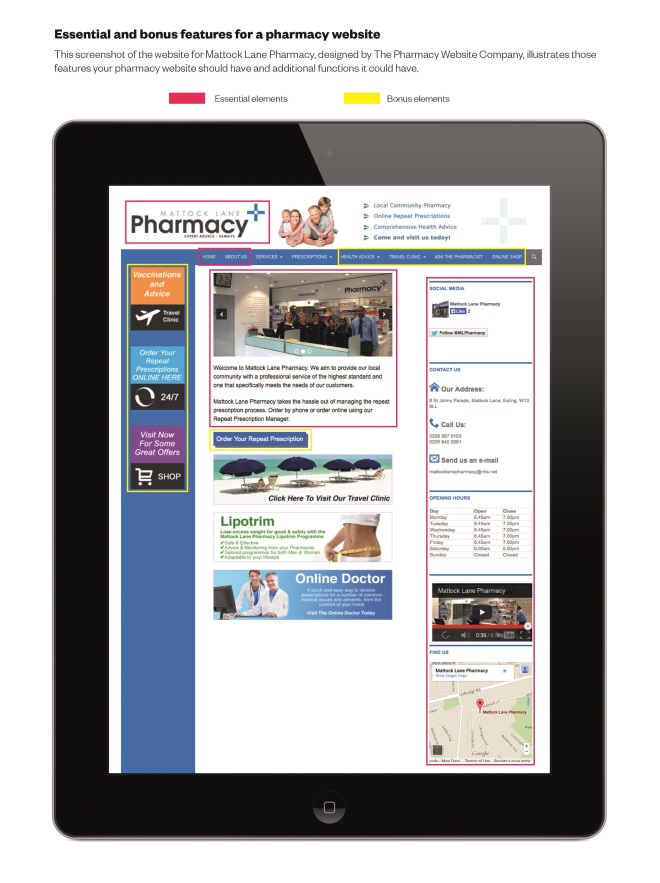
Shutterstock.com
All businesses need to have an online presence but many independent pharmacies do not have their own websites. Online customers may be searching for products and services or may be looking for important information about your pharmacy, such as opening hours or a telephone number. If you do not have a website, this information will come from third parties and you will have no control over what your customers are seeing or where their online search leads them. There is the possibility that they may be directed to a competitor’s website, which could result in the loss of that customer.
A website will allow you to promote your services to a wider audience and is cheaper and more flexible than print advertising. Your business will be visible 24 hours a day, 365 days a year to any customer who can access the internet. There is also the potential for increasing profitability through online sales and an opportunity to tell potential customers why they should choose your pharmacy.
Building your website
Before you can start building your website you will need to choose and register a domain name. It is important to select a name that people will use when searching for your business — it is a good idea to use your pharmacy’s name if possible. Domains are available with a range of domain extensions such as ‘.co.uk’ or ‘.com’. For a UK based company, the ‘.co.uk’ extension is probably the most suitable. However, I recommend that you register the ‘.com’ version too.
The ‘.pharmacy’ extension has also recently become available. However, this is currently only available to pharmacies registered in the United States and the registration process is complicated and expensive.
Once the domain has been registered, you can begin to think about building the site. There are many online services that will provide domain and website hosting, allowing you to build your own site. This is a low cost option for those who want to create a simple website. However, most pharmacy owners will not have the time or ability to undertake this type of project. This can result in a poor quality website, which may be worse than having no site at all. Additionally, if you want to enhance your site with added functionality, such as repeat prescription ordering, then building the site yourself is probably not the best option.
For most pharmacies, using a website designer is a sensible choice. Choosing an appropriate partner can be a minefield and making the wrong choice can be expensive, time-consuming and frustrating. Pharmacy is a unique and complicated business so any provider that you choose will need to understand this and have a good knowledge of the profession. You should ask to see examples of pharmacy websites that the provider has already built and check that it is able to provide unlimited ongoing support to ensure that your website is regularly updated and technical upgrades are installed. Most hosting services will also have an option allowing the pharmacist to update their own content. This may be slightly cheaper but in my experience most pharmacists do not have the time or the ability —or both — to update their own sites. It should also offer flexibility and, above all, value for money — the cheapest option is not necessarily the best option.
You will also need to consider online security and ensure that your hosting service includes a backup facility for your website.
Choosing your features
A basic website — a so-called ‘brochure site’ — will provide information only, including your opening hours, contact details and location. Information on the products and services provided should also be included. Customers access the internet using various devices so ensuring that your website is compatible with mobile phones, tablets and desktop computers is vital.
You will also need to consider the colours and logo that you will be using. You may already have a logo and brand identity for your business. However, you should make sure that the design works aesthetically on a screen. If you do not already have a suitable logo then you will need to enlist the help of a website designer.
Some customers will expect to be able to do more online than simply access information about your pharmacy. You can enhance your website functionality by adding additional features, such as a repeat prescription ordering service. A good system will be easy to use, secure, and have the ability to remind customers to order their repeats via an email or text message. Electronic prescriptions are now a reality and the system should be designed to be able to handle nomination requests.
Pharmacy is recognised as a reliable source of health information and you may want to consider including this on your site — I usually recommend using licensed content from the NHS choices website. Some pharmacy websites also feature an online doctor facility, which allows customers to complete an online consultation with a doctor and obtain a private prescription for a wide range of conditions. This may be an additional source of income for the pharmacy.
Other features you may want to consider include an appointment booking system, a newsletter subscription service and perhaps an interactive blog. Many sites also feature a private area for staff or special subscription sections for registered customers.
You may wish to monitor and analyse the visitors to your website, so ensure your hosting service provides this type of data.
Additionally, you could consider submitting your site to the General Pharmaceutical Council (GPhC) for approval. For a fee, approved sites are entitled to display the GPhC ‘registered pharmacy’ logo. This provides additional reassurance to customers browsing your site that it is a genuine, legitimate pharmacy.

Essential and bonus features for a pharmacy website
This screenshot of the website for Mattock Lane Pharmacy, designed by The Pharmacy Website Company, illustrates those features your pharmacy website should have and additional functions it could have
Maintaining your website
Your website is equivalent to your shop window and needs to be kept relevant and up to date. For example, during the winter you may want to promote your flu vaccination service and offer advice about winter ailments. During the summer you may want to promote travel health and sun protection, as well as providing information about allergy relief. Time and capability are barriers to keeping the site updated, so make sure your website provider can offer support with this.
Promoting your website
The simplest way to promote your website is to make sure that your website address appears on all your business stationery such as receipts, bags and business cards. Also you may want to consider adding your website address to your fascia. A well-designed leaflet is also useful — as well as having the leaflets on display in the pharmacy, you can use them as bag stuffers or arrange a local door-to-door leaflet drop. When designing promotional material for the site, make it clear why your customers should visit your site, for example, to get additional information about your products and services or to order a repeat prescription.
Your website should also be built with search engine optimisation (SEO) in mind. This will help make sure that your site appears in search results from search engines such as Google, Bing and Yahoo. Linking your website to social media such as Facebook, Twitter and Google Plus will help promote your site. Your website designer should be able to help you with leaflet design, online advertising and SEO.
Pay per click (PPC) online advertising, where another website hosts your advert and you pay if users click on it, is also an option. This is probably only worthwhile if you decide to have an online shop.
Creating an online shop
Although you may want to encourage your customers to make purchases in store, many will still prefer to buy online, especially at times when your pharmacy is closed. The easiest way to run an online shop is to use an affiliated or ‘white label’ provider, which would need to be a registered online pharmacy. They would design and build the website and then integrate the online shop. It is not usually possible to add the white label online shop to a website built by another provider. You will then receive a commission for any orders placed via your site. The advantage of this system is that it is low cost and maintenance free for the pharmacy. The disadvantage is that you have no control of the prices and product range available for sale.
If you wish to sell your own products online, you will need to upgrade your website to an ecommerce website. You will need to consider several factors, such as how you will take payments online, website security, what products you will sell, how you will maintain the site, how you will fulfil orders and how much stock you will hold, as well as staff, equipment and warehouse costs. You will also need to make sure that your website is compliant with legal requirements, especially if you are selling medicines online. You will need to populate the site with products including images and descriptions and ensure that your provider can assist you with this. The site should also be easy to navigate so that potential customers can quickly and easily find the items they are looking for.
Your customers are already online — a report from the Office of National Statistics in 2014 found that 76% of all adults in the UK used the internet every day, with 40% of those aged over 65 years reporting daily use. A good quality website will give you the opportunity to grow your business, as well as protecting your existing trade.


